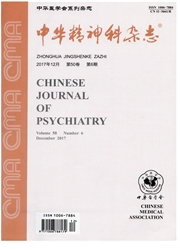

 中文摘要:
中文摘要:
目的通过比较抑郁症患者治疗前后功能影像学变化,初步探讨认知行为治疗对抑郁症患者的神经作用机制。方法对首次发病未服药的抑郁症患者(患者组,13例)和健康对照者(对照组,13名)进行fMRI扫描,患者组在6周的认知行为治疗后再行fMRI扫描;所有被试在扫描中需完成一个含中性、正性、负性表情的性别判断任务;采用SPM8软件进行fMRI数据处理,检测负性及正性条件下的脑激活强度。结果负性表情刺激下,治疗前患者组右侧小脑、左侧中央后回激活较对照组低,治疗后小脑蚓部激活较对照组低,左梭状回、右岛叶、左尾状核、右额中回、左顶下小叶激活较治疗前增高;正性表情刺激下,治疗后患者组左中央前回[蒙特利尔神经科学研究所(MNI)坐标(x、y、z)为-54、0、21,t=4.67,P〈0.05]、右额下回岛盖部[MNI坐标(x、y、z)为48、15、15,t=5.10,P〈0.05]、两侧缘上回[有:MNI(x、y、z)为54、-21、27,t=5.19,左:MNI(x、y、z)为-60、-24、33,t=4.81;均P〈0.05]激活较治疗前降低。结论认知行为治疗可能通过下调反应抑制系统、激活情绪加T及认知监控系统而起效。
 英文摘要:
英文摘要:
Objective To explore the neurobiological mechanisms underlying cognitive-behavior therapy(CBT) for major depressive disorder (MDD) by detecting the neural changes of patients following CBT. Methods Thirteen first-episode treatment-naive patients with MDD and 13 matched healthy volunteers underwent fMRI scan. All the patients were treated with 6-week CBT only and scanned again after treatment. A gender recognition task with neutral, positive and negative expressions was performed by all subjects during each scan. The fMRI data was processed by SPM8 to detect the brain activation in negative and positive condition. Results In negative condition, patients showed decrease of activation in right cerebellum and postcentral gyms compared to the healthy. After treatment, the activation in ve~nis was still lower in patients than the healthy. The patients exhibited increased activation in left fusiform gyms, right insula, left caudate, right middle frontal gyrus and inferior parietal lobule after treatment, and reversed activation in left precentral gyms ( Montreal Neurological Institute ( x, y, z) : - 54,0,21, t = 4.67, P 〈 0. 05 ), right opercular part of inferior frontal gyms ( Montreal Neurological Institute(x,y,z) : 48,15,15 ,t = 5.10,P 〈 0.05 ) and bilateral supramarginal gyms ( tight: Montreal Neurological Institute ( x, y, z ) : 54, - 21,27, t = 5.19 ; left : Montreal Neurological Institute ( x, y, z ) : - 60, - 24,33, t = 4.81 ; P 〈 0.05 ) to positive expressions. Conclusion CBT may work via down-regulation of response inhibition systems and upregulation of emotional processing and cognitive monitor system.
 同期刊论文项目
同期刊论文项目
 同项目期刊论文
同项目期刊论文
 Attributional retraing group therapy versus selective serotonin reuptake inhibitors: neurobiological
Attributional retraing group therapy versus selective serotonin reuptake inhibitors: neurobiological Comparison of the neurobiological effects of attribution retraining group therapy with those of sele
Comparison of the neurobiological effects of attribution retraining group therapy with those of sele 期刊信息
期刊信息
